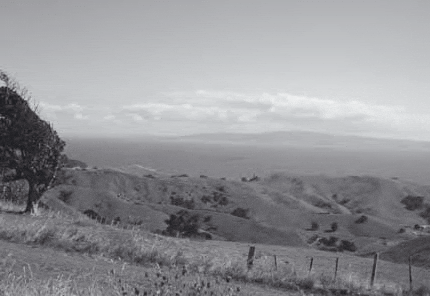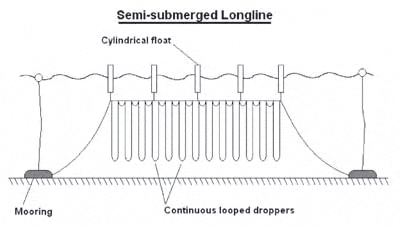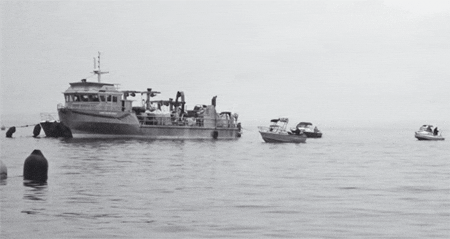Background
For an offshore or open sea mussel farming industry to develop in UK waters, there need to be economic drivers in place to prompt a move offshore. These must be coupled with available technology, suitable physical and biological conditions, an appropriate legislative framework and societal acceptance of such developments.
This article avoids speculation on what might be, but focuses instead on what is actually possible with the conditions and circumstances, as they exist.
There is wide recognition that aquaculture will need further expansion to help supply the growing demand for seafood and there is also recognition that sheltered inshore waters provide little scope for that expansion. Moving aquaculture offshore has been seen as a way of meeting these expansion needs and the concept has been referenced in a number of industry strategy documents at local, national, EU and global levels. Despite that, in the UK at least, there has been little actual progress.
Offshore shellfish farming development programmes are underway in New Zealand, the United States, Ireland, Germany, the Netherlands and Belgium and these include both government and commercially sponsored initiatives. In France and Italy, offshore mussel production has long been a reality and is an important contributor to national production. In the Far East, developments of this nature are vast, both geographically and commercially.

A partially sheltered offshore farm of about 10 square miles seen from 3 miles away
Why move offshore?
Market
Current UK inshore production is both commercially and environmentally sustainable but has a limited capacity for growth due to unreliable seed resources, competition for space and uncertain water quality.
If offshore production leads to an overall increase in supply, then there is a need to consider the market. In Europe and the UK the underlying trend is for increasing demand and static or falling production. This basic picture is unlikely to change in the long term as production in France, Italy and Spain has reached a plateau and there are few areas of coast left where production could be increased. In Holland decreased supplies of seed have led to a steep fall in production. Overall, European production has fallen from 606,000 tonnes in 1998 to 478,000 tonnes in 2005. This has resulted in very high prices, which ultimately affects customer acceptance and the long-term health of the market.
The growing and potentially large market for mussels in the UK has a current low per capita consumption of 0.1Kg, compared to Belgium figures of 4.2Kg. A similar consumption in the UK would provide a market for 250,000 tonnes.
Fresh live mussels by definition have a short shelf life, and it is specifically this high value live market that is in short supply and should be targeted by UK offshore production. Competing with frozen Chilean production is not seen as viable in the long term and does not achieve the premium available to fresh live mussels.
Reduction of production costs
Access to the large space resource available to open water farms would bring the potential for larger tonnages, reductions in unit production costs, and improvements in profitability. Existing rope culture farms in the UK are comparatively small and geographically widespread and with little scope for gear and labour sharing, production costs can be high. In New Zealand where the industry is both large and geographically compact, a high degree of mechanisation is the norm, leading to lower unit production costs. In that industry a single large vessel with a 4-man crew would be expected to harvest, grade and clean 50-100 tonnes per day. While these figures will raise no eyebrows in North Wales, they are an order of magnitude higher than those found on UK rope grown mussel farms.
An offshore farm based around a vessel of that capacity, harvesting 100-150 days per year, would have an annual production of 5,000- 10,000 tonnes, which would bring unit production costs more in line with bottom grown production.
Growth rates
Existing offshore farms in the US and France have shown higher growth rates, better meat yields, and heavier production per rope compared with inshore farms in the same region. This appears to be due to the lower stress, reduced turbidity and better water exchange experienced at the offshore farms. These improvements in productivity rates give higher returns for the capital deployed.
Market image
Shellfish is a product whose quality image is closely linked with its area of production, and mussels produced in a clean offshore environment will gain an image that will serve as a valuable marketing tool, helping to differentiate and add value to the product.

The general layout of a semi-submerged farm
Technology
Simple hanging culture long line systems have been adopted by a number of existing offshore mussel farms around the world. These can be surface floating, semi-submerged or fully submerged according to local conditions. Attempts have been made to operate various designs of raft but they have not proved to be economically or technically viable in the offshore environment. A comprehensive guide to the construction and use of offshore long-line systems has been produced by IFREMER http://www.ifremer.fr/docelec/doc/1991/rapport -1671.pdf. It seems likely that the most suitable design for the UK would be the semisubmerged systems in use on the Atlantic coast of France.
These consist of single headlines, buoyed by tall narrow vertical floats that ride the weather better than barrel type surface floats. Headlines equipped with continuously looped, pegless rope would enable a high level of automation and allow rapid harvesting and husbandry operations. This would minimise production costs and make best use of the short weather windows available offshore.
The vessel required for an offshore farm would need to carry the harvesting and primary processing gear, provide a stable platform for lifting operations and a large load capacity for the harvest. Vessels of this nature are in use in France and New Zealand and would seem to be suitable for UK conditions.
The harvesting, grading and washing equipment would not need to be significantly different to that already in use in inshore water farms.
Physical Conditions
The higher energy environment found offshore will affect farm design and access to the farm. Existing designs survive 7m waves and allow routine farming operations to take place in swells of 2m or so. Farms will need to be situated in areas where working days at sea are sufficient for economic viability. Areas where peak conditions are more extreme would require adaptation of existing designs.
Temperature, turbidity and salinity conditions are suitable for mussel culture around most of the UK coast with the warmer waters to the south and west providing longer growing seasons.
Water depth affects the design and cost of moorings, with the optimum being in the range 15-25m.
Higher current velocities provide better water exchange and higher growth rates, up to a maximum of around 1 knot. Stronger currents can lead to tangling and stock losses. High tidal ranges require more complex and expensive moorings.
Biological Conditions
Phytoplankton abundance, spat availability and the incidence of predator and fouling organisms will all affect the viability of a farm. These factors are all site specific and must be determined by in-situ trials.

An offshore harvesting vessel surrounded by angling boats demonstrating the integration of offshore mussel farms and other activities
Legal Framework
This is fundamentally the same for both inshore and offshore farms out to 12 miles with Food Safety Regulations, 1992 and 1998 applying to all production.
A Crown Estate lease will be required for most areas, while Several and Regulating orders are not relevant to a hanging culture farm. In Scottish waters, planning procedure is well developed and handled by local authorities, while in England and Wales the procedure is currently being developed.

The author in New Zealand examining a sign advertising the presence of an offshore mussel farm
There is exemption for shellfish farms from the need for environmental impact assessments under Statutory instrument 1999/367, however conservation bodies may request a discretionary one if the development were large scale.
In England and Wales, Sea Fisheries Committees have some regulating powers out to 6 miles and are seen as key to successful developments within that zone. Development of farms beyond 12 miles will be legally challenging as well as economically doubtful.
Integration with other interests
For a development that could be both large and novel it would be vital to take into account the interests of other marine stakeholders.
Open water shellfish farms have been shown to be both environmentally benign and to provide a greater economic return from an area than fishing, recreation or conservation alone.
Intelligently situated and well designed, they can provide a degree of access to static gear fishermen, anglers, divers and recreational boating. They can provide food, habitat and nursery grounds to many marine species of commercial and conservation interest and can be shown to enhance biodiversity in an area by acting as a semi-protected zone.
Conclusions
- Market need, greater production and enhanced unit profitability provide the economic imperative for offshore production. This should be considered against the background of greater risk and high establishment costs.
- Areas with suitable physical and biological conditions need to be established by empirical trials and survey.
- The relevant technology exists but may need proving and/or adapting for UK conditions.
- A legal framework is in place but could be improved and streamlined, particularly for England and Wales.
- Societal acceptance is untested and creating it will need practical political support. Recognition of the need for more productive, varied and inclusive use of the marine resource and the inherent sustainability of shellfish farming should make this support forthcoming and the acceptance achievable.
July 2008

